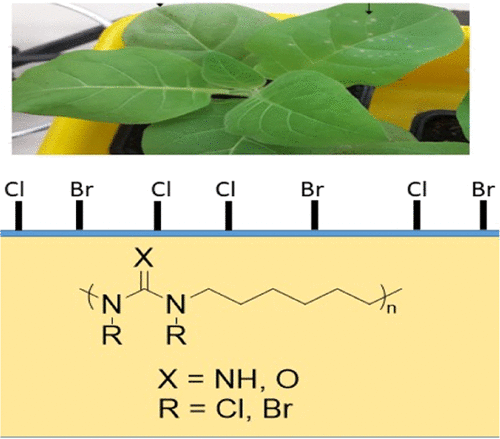当前位置:
X-MOL 学术
›
Biomacromolecules
›
论文详情
Our official English website, www.x-mol.net, welcomes your
feedback! (Note: you will need to create a separate account there.)
Antiviral Polymers Based on N-Halamine Polyurea
Biomacromolecules ( IF 5.5 ) Pub Date : 2021-09-08 , DOI: 10.1021/acs.biomac.1c00920 Noam Y Steinman 1 , Tan Hu 2, 3, 4 , Aviv Dombrovsky 5 , Meital Reches 2 , Abraham J Domb 1
Biomacromolecules ( IF 5.5 ) Pub Date : 2021-09-08 , DOI: 10.1021/acs.biomac.1c00920 Noam Y Steinman 1 , Tan Hu 2, 3, 4 , Aviv Dombrovsky 5 , Meital Reches 2 , Abraham J Domb 1
Affiliation

|
N-halamines are a commonly applied class of antimicrobial agents used for a variety of applications relating to human health. Here, we present the modulation of the common polymers polyurea and polyguanidine with the N-halamine technology. The N–H bonds in either polymer were converted to N–Cl or N–Br bonds capable of releasing Cl+ or Br+ cations to aqueous media as antiviral agents. Controlled release of the oxidizing agents was monitored for a period of 4 weeks. Antiviral activity was evaluated against the T4 bacteriophage as well as against the highly stable plant virus belonging to the Tobamovirus genus, tomato brown rugose fruit virus. The incorporation of the N-halamine technology on commonly used polymers has effectively introduced antiviral functionality for a wide variety of potential applications.
中文翻译:

基于 N-卤胺聚脲的抗病毒聚合物
N-卤胺是一类常用的抗微生物剂,用于与人类健康有关的各种应用。在这里,我们展示了使用N-卤胺技术对常见聚合物聚脲和聚胍的调制。任一聚合物中的 N-H 键都转化为 N-Cl 或 N-Br 键,能够将 Cl +或 Br +阳离子作为抗病毒剂释放到水性介质中。对氧化剂的受控释放进行了为期 4 周的监测。评估了针对 T4 噬菌体以及针对属于Tobamovirus属的高度稳定的植物病毒、番茄棕色皱纹果实病毒的抗病毒活性。所述的引入N-常用聚合物上的卤胺技术有效地为各种潜在应用引入了抗病毒功能。
更新日期:2021-10-12
中文翻译:

基于 N-卤胺聚脲的抗病毒聚合物
N-卤胺是一类常用的抗微生物剂,用于与人类健康有关的各种应用。在这里,我们展示了使用N-卤胺技术对常见聚合物聚脲和聚胍的调制。任一聚合物中的 N-H 键都转化为 N-Cl 或 N-Br 键,能够将 Cl +或 Br +阳离子作为抗病毒剂释放到水性介质中。对氧化剂的受控释放进行了为期 4 周的监测。评估了针对 T4 噬菌体以及针对属于Tobamovirus属的高度稳定的植物病毒、番茄棕色皱纹果实病毒的抗病毒活性。所述的引入N-常用聚合物上的卤胺技术有效地为各种潜在应用引入了抗病毒功能。











































 京公网安备 11010802027423号
京公网安备 11010802027423号